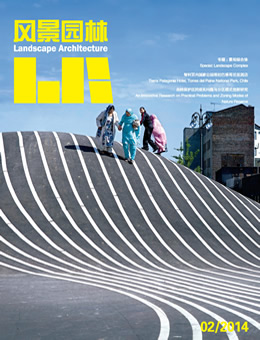刘颂 章舒雯
LIU Song ZHANG Shu-wen
摘要:数字技术改变了风景园林师的思维方式,借助计算机将数学方法应用于风景园林规划设计实践是未来的发展趋势之一。通过分析数学方法的基本原理及其在风景园林研究中的应用实践发现,统计分析法如:时间序列分析、相关分析、回归分析、聚类分析、主成分分析等方法适用于处理各种随机现象、随机过程,进而揭示风景园林的一般规律。而对于景观空间特征的分析,常用景观指数来分析景观要素的分布形态和特征,或借助空间分析模型如地统计学分析、分形理论、小波分析等来揭示景观尺度特征;层次分析法、模糊数学法和灰色关联度分析在景观综合评价中应用广泛;对于景观过程模拟比较常见的2种方法是人工神经网络法和元胞自动机模型;遗传算法在景观格局优化中得到了初步运用。但目前,风景园林学中数学方法的应用还局限于用理想化模型验证方法本身的可行性和准确性研究,应用的领域也局限于风景园林中社会经济现象的统计学分析及区域景观格局研究为主,还需进一步增强应用的深度和广度。
关键词:统计分析法;空间分析法;景观综合评价;景观过程模拟;景观格局优化
基金项目:国家自然科学基金项目“转型期城乡绿地系统优化方法研究”(51378364);高密度人居环境生态与节能教育部重点实验室自主课题“建成环境景观感受信息采集及集成”资助项目
Abstract: Digital technology has changed landscape architects’ thinking pattern. It is one of the tendencies to apply the mathematic methods to the practice of landscape architecture planning and design based on computer. Through reviewing the mathematic method principles and its application of on landscape architecture, the authors found that statistical analysis methods such as time series analysis, correlation analysis, regression analysis, cluster analysis and principal component analysis are used in dealing with many random phenomenon and process to reveal the general rule of landscape architecture. As for landscape spatial characteristic, landscape index are often used to analyze the distribution pattern and features of landscape elements. Spatial analysis models such as geostatistical analysis, fractal theory and wavelet analysis are also used to reveal the landscape scale characteristics. Analytic hierarchy process, fuzzy comprehensive evaluation and grey relational analysis are widely used in the landscape comprehensive evaluation. Artificial neural networks and cellular automata are used to simulate the landscape process. Genetic algorithm has been preliminary used to optimize the landscape pattern. However, mathematic methods application in landscape architecture is limited in the statistical analysis of landscape architecture’s socioeconomic phenomenon and the regional landscape pattern research, which should be popularized and applied in the future.
Key words: Statistic Analysis; Spatial Analysis; Landscape Comprehensive Evaluation; Landscape Process Simulation; Landscape Pattern Optimization
Foundation item: “Urban and Rural Green Space System Optimization Research in Transformation Period” of the National Natural Science Foundation of China (51378364); “Built Environment Landscape Impression Information Collection and Integration” of the independ project of the Key Laboratory of High Density Habitat Ecological Environment and Energy Saving of National Education Ministry
风景园林规划设计是一门艺术与科学相结合的学科。在我国,由于受到传统古典园林思想的影响,风景园林长期被认为是诠释个人情感和精神世界外化的一个手段——该思想使得风景园林规划设计过于强调艺术,忽视了其科学性。随着计算机技术、数学方法的发展和广泛应用,借助计算机平台将数学方法应用于风景园林的研究过程,使其从传统的定性分析转向定量分析的尝试越来越多。而实践证明,数学方法的引入,不仅使风景园林的研究过程更加理性和客观,也使得很多复杂的问题得到解决。
数学方法在风景园林学中的应用方式体现在2个方面:一是利用数学思维和语言对风景园林的问题进行思考和描述,从更深层次揭示问题的机理;二是利用数学分析方法对获取的数据进行分析、计算,从而发现现象背后的内在规律。而这2方面应用的最终目的都是为了加深决策者对于风景园林问题的理解,从而辅助决策。章俊华作了开拓性的专题研究,他曾在《中国园林》从 1998 年开始的“规划设计学中的调查分析法”专栏中连载论文[1],并于2005年出版专著《规划设计学中的调查分析法与实践》[2]。本文旨在总结国内外关于风景园林中常用的数学方法的功能、基本原理及应用方向,以促进数学方法在风景园林领域的应用。(未完待续)
 《风景园林》2014第2期导读
《风景园林》2014第2期导读
Leave a Reply